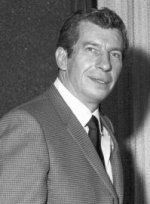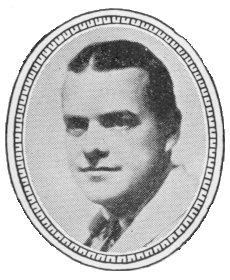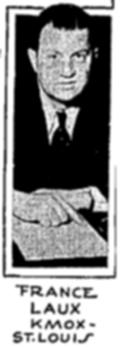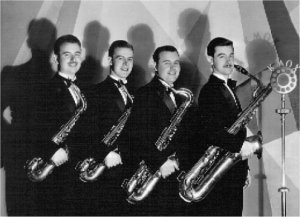It was the night of the Harding-Cox presidential election, November 6, 1920. At the very same moment KDKA “made history” by broadcasting the results, a couple of 20ish year-old kids were doing the same thing over 500 miles away on a transmitter they built in the basement of a home in St. Louis. They’d been playing with radio gear since 1914, and had also operated an amateur spark station.
Lester Arthur “Eddie” Benson and his partner William Wood did not have the public relations machine that Westinghouse did, and there are factual holes in published accounts, but if press reports are to be believed, they may well be considered the fathers of St. Louis radio. For example, an article in the June 15, 1934, issue of Broadcasting magazine credits Benson with the building of the first transmitters for KSD and KFVE.
On the other hand, there was only one article referring to his supposed technical achievements. That article also says he attended Washington University in St. Louis, but a school spokeswoman said no records could be found listing Benson as a student there. His obituary, published in the St. Louis Globe-Democrat December 18, 1972 says “He made the first police radio broadcast on WIL in 1921 from a moving car, with the police chief along supervising the broadcast.” Yet neither WIL nor its predecessor WEB existed in 1921.
Building KSD
KSD was owned by the St. Louis Post-Dispatch, and the paper vigorously promoted that station’s experimental broadcasts. Through supposition, one can assume these were the broadcasts made on Benson’s transmitter, and they led up to KSD’s obtaining the first Class B license issued in the United States in March of 1922. Benson’s name never appears in any of these articles, but there are brief descriptions of the “transmitting device:” “Technically, the small transmitter…makes use of six five-watt power tubes, or 30 watts in all…The small transmitter panel and its apparatus could be picked up by a boy and carried away under one arm.”
The Broadcasting article says Eddie Benson had been commissioned in 1920 to build an experimental transmitter at the Post-Dispatch plant in downtown St. Louis and indicates this transmitter was used when KSD went on the air experimentally in 1922.
The experimental broadcasts were described in the paper on February 14, 1922: “Amateur radio stations in and around St. Louis are notified that a ‘QST’ signal will be sounded at 7:45 this evening for the purpose of a test demonstration of the wireless station installed in the Post-Dispatch building. Shortly afterward, the entire first act of the musical play now appearing at the American Theater, ‘Two Little Girls in Blue,’ will be sent broadcast by wireless – overture, songs, dialogue, everything presented on the stage during the first act will go out instantaneously through the Post-Dispatch radio apparatus. Wave length, 360 meters.”
It appears Benson’s device also was put into operation when KSD officially signed on March 11, 1922, but arrangements had already been made to replace it with a new Western Electric transmitter in June of that year.
Benwood Radio, KSD and WEB
One reference in a KSD article tells how they had to run down the street to an electronics shop after transmitter failure during an experimental broadcast. Less than half a block away from the KSD studios in downtown St. Louis was Benwood Radio Company, the parts and service store founded by Eddie Benson and William Wood.
By now things had been humming at Benwood for some time. Land station 9ZB was established there in 1920, and the talented young men were building a transmitter and filling out the necessary papers to put WEB on the air. Experimental broadcasts for WEB had begun February 9, 1922, at 375 meters. In what appears to have been a status race of sorts, the St. Louis Star had hitched its wagon to Benson’s station and wrote in its February 8, 1922, issue, “The first program to be given by wireless under the auspices of a St. Louis newspaper will be presented tomorrow night, commencing at 7:45 o’clock from the offices of the Benwood Company, Inc., 1110 Olive Street, pioneers in the development of wireless apparatus in St. Louis.”
The Star had no ownership position with WEB, but that didn’t stop the paper from milking their “cooperating relationship” with Benson, although his profile in all the hoopla was fairly low. There is one mention on February 10: “…a young man with a set of telephone receivers strapped on his head was talking into a transmitter. Every now and then he would adjust some numbered discs on a strange wood box and listen to what was being said on the other end of a wire that wasn’t there. In addition there were a few peculiarly fashioned boxes and coils and a few electric lights on a black board. That was all, but it seemed an unexplainable mess until the young man took the apparatus off his head and gave a three-minute lecture that took all the mystery away. He was L.A. Benson, vice president of the Benwood Company, who was in charge of the sending.”
Although the St. Louis Post-Dispatch got their own transmitter and severed their relationship with him, Benson had the last laugh. After a couple years of the relationship with the Star, his company took full control of WEB and changed the call letters to WIL. In later years it was said WIL was the market’s first station to sell commercial time.
The Benson Broadcasting Company also reportedly figured in the history of KFVE, licensed to University City in suburban St. Louis. The original license holder was the Film Corporation of America and a published report indicates Benson built the transmitter for the station’s sign-on in 1924, and he later bought the station.
Rocky Road in Life
That same year, Eddie took the big step down the aisle, marrying on July 24. He and wife Doris would weather marital storms, but the marriage itself would eventually dissolve in acrimony. Things went better at the station: In the 1930s, at a time when the country was in the throes of the Depression, Eddie Benson threw annual picnics for his radio staff, bringing in substitute engineers and announcers for the day. One newspaper account stated, “There is never a dull moment…he is acknowledged a genial host.”
In 1933 he completely remodeled the WIL studios and added a roof garden for the staff. Eddie Benson also was also a ham radio operator and served as Midwest manager of the American Radio Relay League. He claimed to have been the first person in St. Louis to do baseball play-by-play in 1926, and he was actively involved in the operation of WIL until it was sold to Balaban in 1957.
The marriage situation, however, worsened. After repeated attempts at reconciliation, Doris and Eddie separated in 1939; eventually she claimed he deserted her and their daughter Leslyanne on December 28, 1941. Two months later he informed his wife he would not be returning to their home in South St. Louis, having taken up residence in the tony suburb of University City. He filed for divorce, alleging “general indignities, mental cruelty, nagging, violent temper and habitual suspicion” but the filing was later dropped. Doris Benson counter-filed for divorce in 1951, testifying she had made repeated attempted to persuade him to return. The judge awarded her a substantial settlement.
His active involvement in the family-owned radio station was not without controversy. Eddie’s own brother Clarence sued him in 1934 in an effort to prevent what Clarence called a usurping of rights in the company. Clarence also showed his distrust for his brother’s management style by requesting an audit, alleging Eddie had overdrawn his banking account in what was then known as Missouri Broadcasting Company. A later judicial decree ended the family battle, and Eddie bought out his brother’s interest in the station in 1948.
Lester Arthur “Eddie” Benson died December 16, 1972 at the age of 72. Although mentioned by name in relatively few newspaper accounts, he clearly built transmitters, owned stations, and was a local “figure.” Hence, we can remember Eddie Benson as one of the two men who got broadcasting started in St. Louis.
(Reprinted with permission of the Radio Guide. Originally published 3/04)



